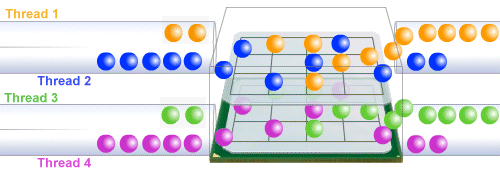In October 1989, envisioning the future through the lens of Moore’s Law, four Intel technologists authored an article entitled Microprocessors Circa 2000 which predicted that multi-core processors could come to market soon after the turn of the century. Fifteen years later their predictions proved true, and multi-core processor capability development had become one of the top business and product initiatives for both Intel and rival chipmaker AMD.
Explained most simply, multi-core processor architecture entails silicon design engineers placing two or more processor-based computational engines within a single processor. This multi-core processor plugs directly into a single processor socket, but the operating system perceives each of its execution cores as a discrete logical processor with all the associated execution resources. This differs from Hyper-Threading technology, which computes with a single core using existing execution resources more efficiently to better enable threading.
By divvying up the computational work performed by a single microprocessor core in traditional microprocessors and spreading it over multiple execution cores, a multi-core processor can perform more work within a given clock cycle. To realise this performance gain, the software running on the platform must be written such that it can spread its workload across multiple execution cores. This functionality is called thread-level parallelism or threading. Applications and operating systems that are written to support it are referred to as threaded or multi-threaded.
A processor equipped with thread-level parallelism can execute completely separate threads of code. This can mean one thread running from an application and a second thread running from an operating system, or parallel threads running from within a single application. Thread-level parallelism is of particular benefit to many multimedia applications because many of their operations are capable of running in parallel.
When combined with Hyper-Threading, Intel dual-core processors will be able to process four software threads simultaneously by more efficiently using resources that otherwise may have remained idle:

The first Intel dual-core processor for desktop platforms, codenamed Smithfield and based on 90-nm process technology, debuted in 2005. The mainstream chip will be referred to as the Pentium D, and will be given a model number starting with 8. It will have Hyper-Threading disabled. The new dual core Pentium Extreme Edition will use the same numbering system as the Pentium D, and will differ only by having Hyper-Threading enabled.
- Pentium Architecture
- Pentium Pro
- Pentium MMX Technology
- Pentium II
- Pentium SEC
- Pentium “Deschutes
- Pentium Xeon
- Pentium III
- Pentium Tualatin
- Pentium 4
- Pentium Northwood
- Hyper-Threading Technology
- Pentium Prescott
- Pentium Processor Numbers
- Multi-Core Processors
- Pentium Smithfield
- Pentium D
- Pentium Roadmap